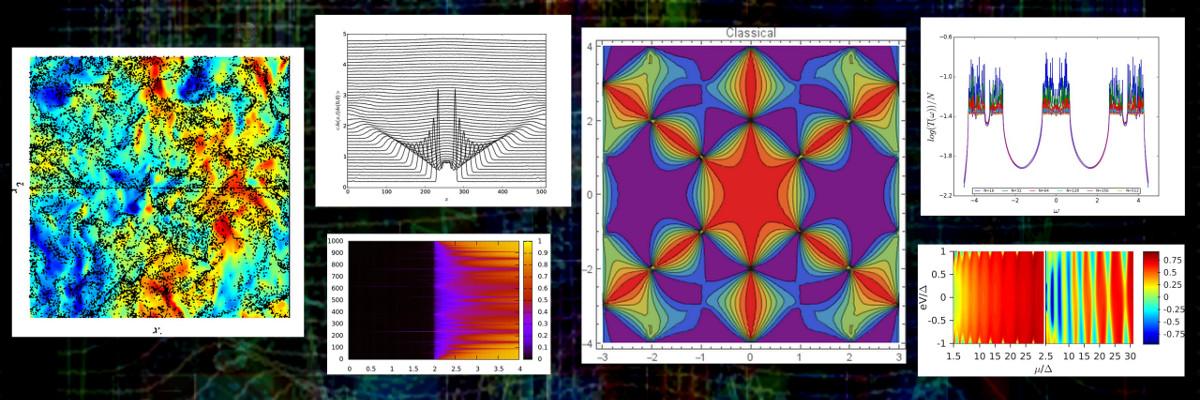Research in this group is focused on a variety of problems in the areas of statistical physics and condensed matter physics. Some specific examples are given below.
- Anomalous heat transport in low-dimensional systems
Many studies over the last few decades, indicate that, in low dimensional macroscopic systems, Fourier’s law of heat conduction is not valid. It appears that heat flow is not diffusive but instead super-diffusive which means that the thermal conductivity of low-dimensional materials is infinite. In our group, efforts are focused on establishing this fact, establishing universality classes and in finding the correct hydrodynamic description of such systems. So far, these results are established for the simplest non-trivial models and a big challenge is to extend these studies to more realistic models, which would be directly relevant for understanding transport in systems such as nanowires, nanotubes, polymers and also two dimensional systems such as graphene.
- Quantum transport
There is research on developing a microscopic theory of electric and heat transport and in understanding noise and fluctuations in open quantum systems, These research areas involve basic and fundamental problems in theoretical physics and at the same time are of great current interest because they are directly relevant for understanding experiments at the micro- and nano- scales. Some of the techniques that are being investigated here include quantum Langevin and quantum master equations, including the Redfield and Lindblad approaches. Diagrammatic Keldysh nonequilibrium Green's function approach is also used in the group to investigate Open Quantum Systems. Applications of the formalism have been made towards understanding transport in quasi-periodic systems such as the Aubry-Andre-Harper model which is a simple one-dimensional system with a rich non-equilibrium phase diagram.The group is interested in using these methods for understanding systems such as light-matter hybrid systems, cavity-QED and circuit-QED systems, and look at fundamental aspects (such entanglement, transport, fluctuations) as well as potential device applications.
- Stochastic many particle systems
Usually when many interacting particle systems are taken out of equilibrium by driving them locally, globally or through boundaries, in low dimensions they manifests themselves through various interesting phenomena like anomalous tagged particle diffusion, appearance of long range correlations (both static and dynamic), anomalous transport, nonlinear and singular temperature profiles etc. Our group is focused on understanding such features at large length and time scales using appropriate hydrodynamic as well as microscopic descriptions.The group is also interested in some other topics which include stochastic processes, fluctuations and large deviations in non-equilibrium systems, extremal and geometrical properties of Brownian motions, first-passage problems and related stochastic search problems. Another recent direction we are pursuing is towards obtaining rigorous results for the stochastic dynamics of so called active particles.
- Quantum many-body physics
Quantum systems with many interacting degrees of freedom like electrons show a rich array of emergent behaviour like magnetism, superconductivity. Recent discovery of a large number of materials including high temperature superconductors, various frustrated magnets, fractional quantum Hall systems and topological band insulators seem to indicate the existence of a whole new class of condensed matter phases whose properties cannot be captured within the conventional paradigm of condensed matter theory. Present research suggests that a proper understanding of these new phases would have to take into account the the subtle interplay of symmetries and quantum entanglement. The work of our group focuses on understanding such phases both from the point of view of theoretical framework building and experimental phenomenology. More particularly, the interest is in unconventional quantum magnets called quantum spin liquids, interacting symmetry protected topological phases, correlated metals and interplay of spin-orbit coupling and electron correlations in such systems.
- Dynamics of Integrable Models
The group is interested in dynamics of integrable models (for e.g., Calogero model and its various generalizations and the Toda system) both from microscopic and collective field theory point of view. In particular, solitons and duality in integrable models and the form of dynamical correlation functions are under investigation. Connection of physical systems (such as a collective behaviour of cold atoms) with integrable and non-integrable PDE’s is an active area of interest for the group.
You can visit the individual homepages of the members of this group to find out more about their research activities and collaborations.
Opportunities:
- Airbus Postdoctoral Prize Fellowships in turbulence and inertial particles in turbulent fluid flows.
- Postdoctoral fellowships in statistical physics.


